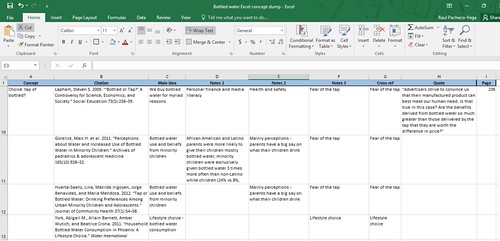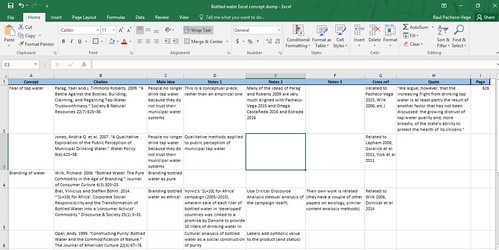Since I’m writing a series of posts on literature reviews (and undertaking a few of my own), I figured I could expand on how you can combine citation tracing, concept saturation, results’ mind-mapping with a method that Professor Elaine Campbell showcases in her excellent post “How I use Excel to manage my literature review“.
I call this technique the “Conceptual Synthesis Excel dump” – I call it “dump” because I basically throw into the Excel file everything that is already in my research and conceptual/reflective memoranda. Doing the conceptual synthesis Excel dump as you do your reading allows you to create a nice map of the literature. It also helps reach conceptual saturation during the literature review.
What I am showing here is my Excel dump on bottled water. There are a number of themes (if you’re doing coding in qualitative methods, you’ll understand what I mean) that interest me:
- Fear of the tap water.
- Decisions on whether to consume tap water vs. bottled water.
- Branding water and bottled water and the use of branding techniques in promoting bottled water.
- Ethical bottled water.
I am showing three screen captures of the Excel file I created. Note that the columns I use are the following:
- Concept – here I list the main idea or major theme of the specific literature review.
- Citation – here I include the full citation (article, book, book chapter).
- Main idea – here I summarize the full article in a sentence or two.
- Notes 1 – here I make notes about specific ideas or whether I agree or disagree
- Notes 2 – same as the above
- Notes 3 – same as the above
- Cross-reference – which references and citations are linked to one another.
- Quote/quotation – specific quotes, as per my memorandum technique, that could be useful
- Page – the page from where I drew the quote. Note that I can draw several quotes from same article
My Conceptual Synthesis’ Excel dump technique is quite handy in the process of creating a literature review (both to reach concept saturation and to create the mind map). Hopefully it will be helpful to you too! I wrote this post partly as a response to the tweet below 🙂
Love this – kind of like @raulpacheco's memo-ing, only in spreadsheet form 🙂 https://t.co/yT9pjaVChx
— Rebecca Linnett (@rebeccalinnett) June 15, 2016
IMPORTANT EDIT – After many requests, I finally got around creating a Conceptual Synthesis Excel Dump template that you can download and edit for your own purposes. I use a framing theory paper but you can adapt to your needs.




In Excel, I actually am going to attempt to color code all of this so my neurodivergent brain can make sense of it instead of just seeing words and boxes! That way I can read across better. This helps me a great deal as an assistant.
Thanks a lot !